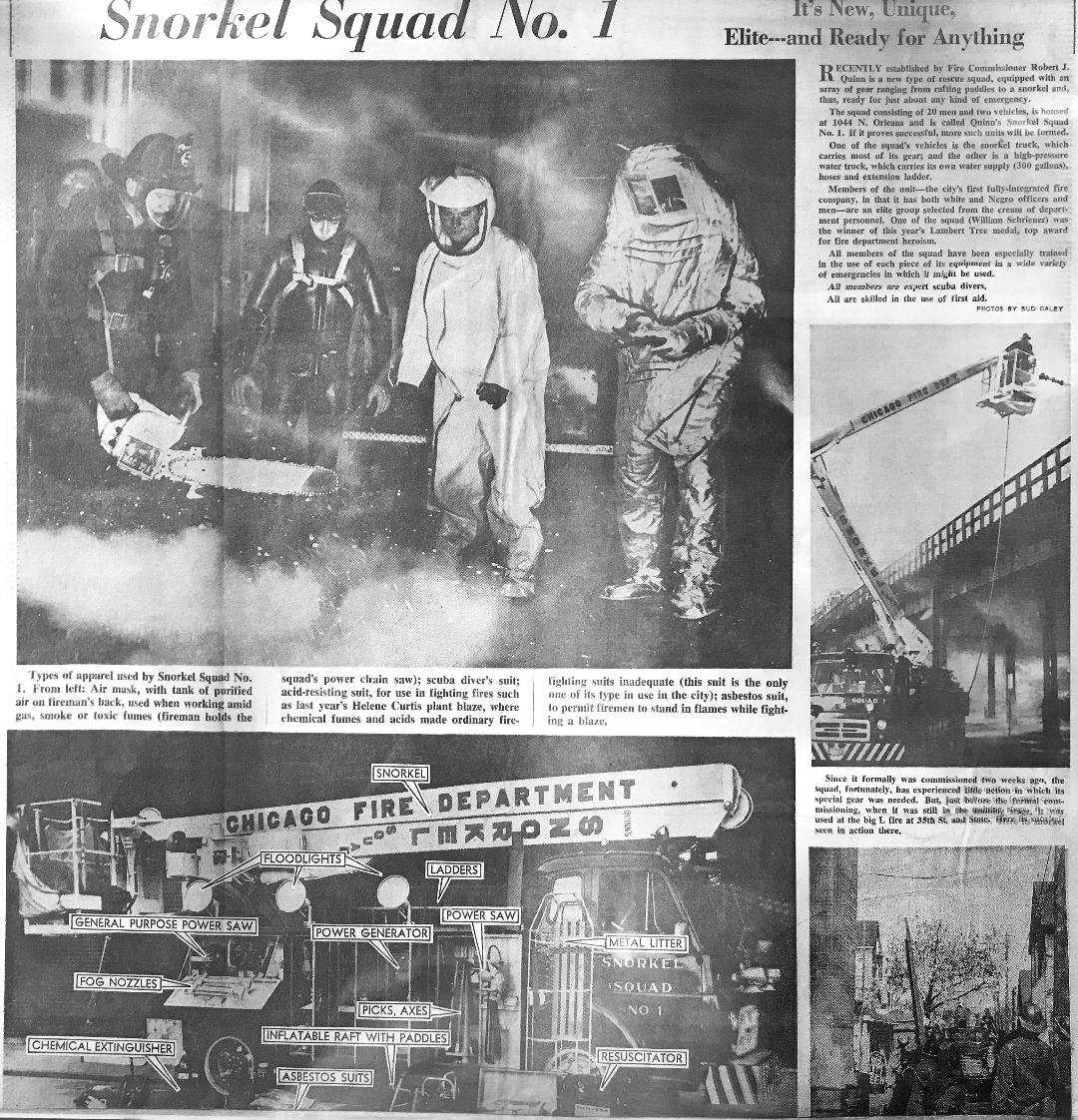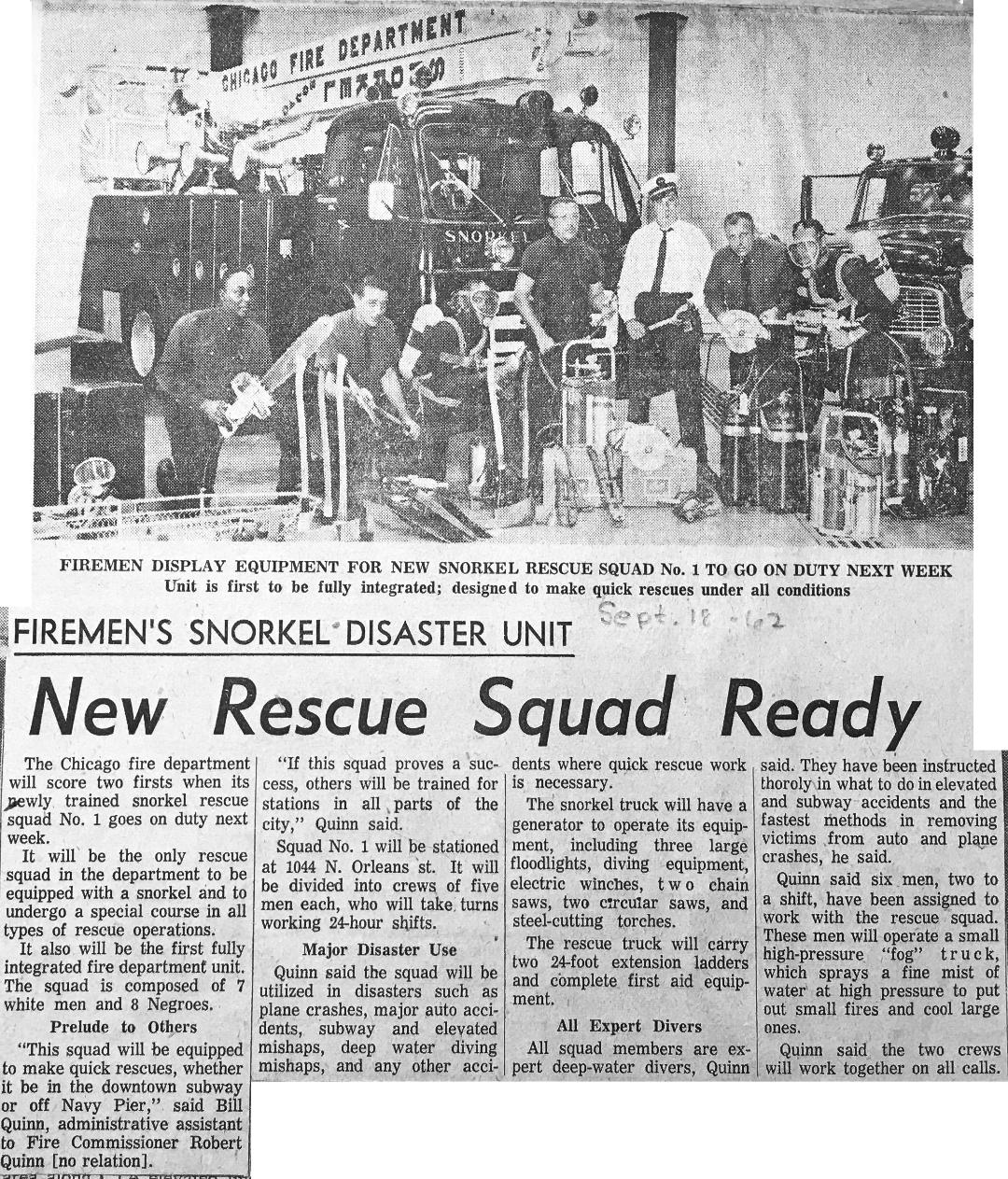This from Steve Redick:
September 1962 the brand new SS1 enters service. My dad can be seen in the photo above the “Rescue Squad Ready” article. What an exciting time to be on the CFD back then.Enjoy the history. I’m so glad dad kept these articles.Steve Redick





















































#1 by Mike Mc on September 10, 2019 - 12:35 AM
Excellent summary Bill. They certainly were state of the art with regard to equipment and much more capable than the Autocar squads. Unfortunately, they are forgotten today and lost to history. A mere footnote, like the salvage and flying manpower squads. If Commissioner Galante, when he merged three squads with three snorkels in 1983 as a two piece company had named them snorkel squads – which they were by his own admission – instead of squads, and had he numbered them 1 through 3 instead of by district, the snorkel squads might be almost as well known nationally as the FDNY Rescue Companies. The current squad members in the CFD mistakenly believe their ancestors were the Autocar squads and probably never even heard of the snorkel squads.
Three fire commissioners: Lou Galante, Ed Altman, and Bob Hoff came from the snorkel squads as well as at least one chief of fire suppression, Pat Kehoe, and numerous deputies, district chiefs, and DDC’s.
#2 by Bill Post on September 3, 2019 - 8:50 PM
Thanks for sharing the article about the Snorkel Squad 1 Steve.
Even though the Snorkel squad was put in former Fire (Salvage) Patrol 5’s quarters at 1044 N Orleans in September of 1962, I understand that they didn’t officially go into service until October 1st.
If you read the article they quote Fire Commissioner Quinn as if the Snorkel squad and the fog pressure units were separate fire companies. First they mention that the squad will run with five men and then a few paragraphs later he says that the fog pressure has six men assigned with two per shift. He also said that it would work with the rescue squad. When Snorkel Squad 1 and Snorkel Squad 2 were put in service the fog pressure units that were assigned to run with them had originally been assigned as separate companies, but at the last minute they became the second unit for the Snorkel squads. The fog pressure that was assigned to Snorkel Squad 1 was originally assigned as Fog Pressure 4 and Fog Pressure 5 was reassigned as the second piece to Snorkel Squad 2. When Snorkel Squads 1 and 2 officially went in service they re-designated Fog Pressure 4 and as SS1A and Fog Pressure 5 as SS2A. Within a short period of time new fog pressure wagons were purchased. Fog Pressures 4 and 5 went in service as new companies while the Snorkel squads continued operating with their fog pressures units as their second piece.
Snorkel Squad 2 went in service about a year after Snorkel Squad 1 when Engine 60 and Truck 37’s new house opened on September 4th 1963.
Even though Snorkel Squad 1 and 2 were new companies, their first pieces which had 40-foot Snorkels and cabinet-style bodies had been retrofitted onto two of the 1956 International Harvester former high pressure wagons (not to be confused with fog pressure units). There were five 1956 high pressure wagons however the CFD took two of them out of service in 1960/61 to retrofit them as Snorkel squads.
At the time Snorkel Squads 1 and 2 were put in service there were also 13 squad companies. Snorkel Squads 1 and 2 didn’t replace any of the 13 companies. When Snorkel Squad 3 was put in service on May 16, 1965 it was a different story as they took Squad 7 out of service and relocated Engine 66 to make room for Snorkel Squad 3. Snorkel Company 1 was taken out of service as Snorkel Squad 3 was using Snorkel 1’s GMC/Pitman 50-foot Snorkel. Squad 12 had been taken out of service in July of 1964 in order to put Truck 62 in service at Engine 80’s new quarters on July 9th.
The Snorkel squads were the only fire companies that had state of the art equipment. They alone had modern SCBAs, power tools including power saws, (besides the Light Wagons) and multi-versals. One reason why all three of the Snorkel squads were due on the same 2-11 alarms is so the multi-versals could be used and they could use power saws to open up the buildings.
In Chicago the trucks didn’t start getting K/12 saws until the late 1960s and early 1970s. The engines got multi-versals during the same time frame. Engines and trucks began to receive the modern SCBAs in the mid to late 1970s. At first it was only the companies near the loop.
The conventional squad companies might have looked sharp but most of their equipment was from the 1940s and 30s. They only had a few Mc Kaa masks which were an outdated type of SCBA. The air tanks were mounted on the firefighters’ chest while newer air cylinders were on a firefighter’s back. The Snorkel squads had an SCBA for each member unlike the conventional Squad companies who also didn’t have any power saws. Of course the Hurst tool wasn’t invented yet. They had to use hand pumped Porta-power jacks.The Snorkel squads during the 1960s were the only companies where firefighters had state of the art tools and masks.